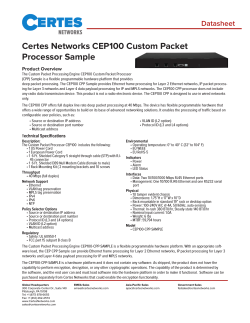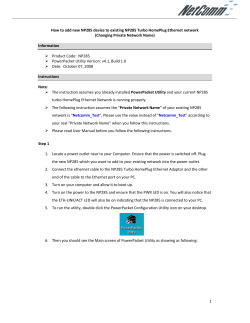
M1CFP4QSFP28CXP Triple-Media 100/40/10G test module
n o i s r e V A T BEM1CFP4QSFP28CXP TM Xena Networks The price/performance leaders in Gigabit Ethernet Test & Measurement Triple-Media 100/40/10G test module The M1CFP4QSFP28CXP is a “triple-media” and “tri-speed” 100/40/10G test module for the XenaCompact and XenaBay chassis. This unique test module supports three transceiver form-factors: CFP4 (CAUI-4), QSFP28 (CAUI-4), QSFP+ (CAUI), and CXP (CAUI) and users can choose any one of these transceiver form factor to be active at any time. When the CXP form-factor is selected, the user can, in addition to a single 100G test port, also use the test module to provide two 40G test ports or eight 10G test ports. This flexibility and price/performance makes it ideal for BERT, load-stress, and functional testing of Ethernet equipment and network infrastructure. Product Order Number XenaCompact C1-M1CFP4QSFP28CXP100 100G/40G/10G XenaBay M1CFP4QSFP28CXP TOP FEATURES • • • • • Tri-speed flexibility Triple-media flexibility Price/performance Ease of use Free software (incl. XenaManager-2G, XenaIntegrator, XenaScripting, Xena2544, Xena1564, Xena3918, and Xena2889) • Free 12-month hardware warranty • 36 months free software updates • Free tech support product lifetime The tri-speed, triple media is a unique feature that gives test engineers enormous flexibility. CXP = 100/40/10G QSFP28 or QSFP+ = 100/40G CFP4 = 100G PORT LEVEL FEATURES Interface category Number of test ports (software configurable) Interface options Number of transceiver module cages Port statistics 1) Adjustable Inter Frame Gap (IFG) Transmit line rate adjustment Transmit line clock adjustment ARP/PING Field upgradeable Tx disable IGMPv2 multicast join/leave Histogram statistics 1) Loopback modes Oscillator characteristics CXP : 100G, 40G, and 10G Ethernet CFP4/QSFP28 : 100G Ethernet QSFP+ : 40G Ethernet CXP : 1 x 100G / 2 x 40G / 8 x 10G CFP4/QSFP28 : 1 x 100G QSFP+ : 1 x 40G CXP : 100GBASE-SR10, 40GBASE-iSR4 / 8 x 10GBASE-iSR CFP4 : 100GBASE-SR4 , 100GBASE-LR4, 100GBASE-CR4 QSFP28 : 100GBASE-SR4 , 100GBASE-CR4 QSFP+ : 40GBASE-SR4, 40GBASE-LR4 1 x CXP, 1 x CFP4, 1 x QSFP28/QSFP+ (one cage can be used at a time) Link state, FCS errors, pause frames, ARP/PING, error injections, training packet All traffic: RX and TX Mbit/s, packets/s, packets, bytes Traffic w/o test payload: RX and TX Mbit/s, packets/s, packets, bytes Configurable from 16 to 56 bytes, default is 20B (12B IFG + 8B preamble) Ability to adjust the effective line rate by forcing idle gaps equivalent to -1000 ppm (increments of 10 ppm) From -400 to 400 ppm in steps of 0.001 ppm (shared across all ports) Supported (configurable IP and MAC address per port) System is fully field upgradeable to product releases (FPGA images and Software) Enable/disable of optical laser or copper link IGMPv2 continuous multicast join, with configurable repeat interval Two real-time histograms per port. Each histogram can measure one of RX/TX packet length, IFG, or Latency distribution for all traffic, a specific stream, or a filter • L1RX2TX – RX-to-TX, transmit byte-by-byte copy of the incoming packet • L2RX2TX – RX-to-TX, swap source and destination MAC addresses (*only at 10G) • L3RX2TX – RX-to-TX, swap source and destination MAC addresses and IP addresses (*only at 10G) • TXON2RX – TX-to-RX, packet is also transmitted from the port • TXOFF2RX – TX-to-RX, port’s transmitter is idle • Port-to-port – Inline loop mode where all traffic is looped 100% transparent at L1 • Initial Accuracy is 3 ppm • Frequency drift over 1st year: +/- 3 ppm (over 15 years: +/- 15 ppm) • Temperature Stability: +/- 20 ppm (Total Stability is +/- 35 ppm) www.xenanetworks.com TM n o i s r e V A T BE Xena Networks The price/performance leaders in Gigabit Ethernet Test & Measurement 40G FRAMED PRBS AND PCS LAYERS Payload Test pattern Error Injection Frame size and header Alarms Error analysis PCS virtual lane configuration PCS virtual lane statistics PRBS 2^31 Manual single shot bit-errors or bursts, automatic continuous error injection Fixed size from 56 to 9200 bytes, any layer 2/3/4 frame header Pattern loss, bit-error rate threshold bit-errors: seconds, count, rate mismatch ‘0’ / ‘1’: seconds, count, rate logging and analysis of bit-error event timing User defined skew insertion per Tx virtual lane, and user defined virtual lane to SerDes mapping for testing of the Rx PCS virtual lane re-order function. Relative virtual lane skew measurement (up to 2048 bits), sync header and PCS lane marker error counters, indicators for loss of sync header and lane marker, BIP8 errors TRANSMIT ENGINES Number of transmit streams per port Test payload insertion per stream Stream statistics 1) Bandwidth profiles Field modifiers Packet length controls Packet payloads Error generation TX packet header support and RX autodecodes Packet scheduling modes 64 (wire-speed) Each stream can generate millions of traffic flows through the use of field modifiers Wire-speed packet generation with timestamps, sequence numbers, and data integrity signature optionally inserted into each packet. TX Mbit/s, packets/s, packets, bytes, FCS error, Pause Burst size and density can be specified. Uniform and bursty bandwidth profile streams can be interleaved 16-bit header field modifiers with inc, dec, or random mode. Each modifier has configurable bit-mask, repetition, min, max, and step parameters. 2 modifiers per stream Fixed, random, butterfly, and incrementing packet length distributions from 56 to 9200 bytes Repeated user specified 1 to 18B pattern, a 8-bit incrementing pattern Undersize length (56B min) and oversize length (9200 max.) packet lengths, injection of sequence, misorder, payload integrity, and FCS errors Ethernet, Ethernet II, VLAN, ARP, IPv4, IPv6, UDP, TCP, LLC, SNAP, GTP, ICMP, RTP, RTCP, STP, MPLS, PBB, or fully specified by user • Normal (stream interleaved mode) – standard scheduling mode, precise rates, minor variation in packet inter-frame gap. • Strict Uniform – new scheduling mode, with 100% uniform packet inter-frame gap, minor deviation from configured rates • Sequential packet scheduling (sequential stream scheduling). Streams are scheduled continuously in sequential order, with configurable number of packets per stream RECEIVE ENGINE Number of traceable Rx streams per port Automatic detection of test payload for received packets Jitter measurement 480 (wire-speed) Stream statistics 1) • RX Mbit/s, packets/s, packets, bytes. • Loss, payload integrity errors, sequence errors, misorder errors • Min latency, max latency, average latency • Min jitter, max jitter, average jitter ±16 ns 8 ns (Latency measurements can calibrate and remove latency from transceiver modules) • 4 x 64-bit user-definable match-term patterns with mask, and offset • 4 x frame length comparator terms (longer, shorter) • 4 x user-defined filters expressed from AND/OR’ing of the match and length terms. Per filter: RX Mbit/s, packets/s, packets, bytes. Latency measurements accuracy Latency measurement resolution Number of filters: Filter statistics 1) Real-time reporting of statistics and latency, loss, payload integrity, sequence error, and misorder error checking Jitter (Packet Delay Variation) measurements compliant to MEF10 standard with 8 ns accuracy ADVANCED TIMING FEATURES Selectable Tx line rate Tx line rate can be referenced to either local clock oscillator (adjustable in steps of 1 ppm), SMA input, or from the Rx line rate for Synchronous Ethernet applications. The Tx line rate complies with SONET/SDH/SyncE with respect to wander and jitter. Jitter attenuation Selectable loop bandwidth for jitter attenuation: 114 Hz, 229 Hz, 460 Hz, 1864 Hz, or 7834 Hz loop bandwidth SMA input • • 1) Counter size: 64 bits 10.0 MHz, or 2.048 MHz Tx line rate reference clock SMA input (Drift/wander is passed from SMA input to Tx line rate) 250mV-2.5V, loaded 50 ohm, square wave format TM n o i s r e V A T BE Xena Networks The price/performance leaders in Gigabit Ethernet Test & Measurement CAPTURE Capture criteria Capture start/stop triggers Capture limit per packet Wire-speed capture buffer per port All traffic, stream, FCS errors, filter match, or traffic without test payloads Capture start and stop trigger: none, FCS error, filter match 16 – 9200 bytes 256 kB for 100G 128 kB for 40G Low speed capture buffer per port (10Mbit/s speed) 4096 packets (any size) The triple media capability of the M1CFP4QSFP28CXP is clearly illustrated here with the trunk cable from the CXP interface ready to provide up to 8 x 10G ports, while the QSFP28 and the CFP4 interfaces each provide a 100G test port. CXP 1 x 100G 2 x 40G 8 x 10G NOT IN BETA RELEASE: The following features will first be available in the official release: • 100GBASE-CR4 • 100G FEC • QSFP+ 40G • Ethernet Autoneg Control CL72+CL73 • Advanced timing features Xena Networks is an award-winning manufacturer of advanced Gigabit Ethernet test and measurement solutions. PHYSICAL ENVIRONMENTAL 1U XenaCompact • W: 19” (48.26 cm) • H: 1.75” (4.45 cm) • D: 9.8” (25 cm) • Weight: 10 lbs (4.5 kg) • Operating Temperature: 10 to 35º C • Storage Temperature: -40 to 70º C • Humidity: 8% to 90% non-condensing 4U XenaBay • W: 19” (48.26 cm) • H: 7” (17.78 cm) • D: 19.7” (50 cm) • Weight: 36.4 lbs (16.5 kg) • Slots: 1 slot in XenaBay REGULATORY FCC (US), CE (Europe) QSFP28 1 x 100G or QSFP+ 1 x 40G CFP4 1 x 100G POWER • AC Voltage: 100-240V • Frequency: 50-60Hz • Max. Power: 90W (XenaCompact) / 120W (XenaBay) • Max. Current: 0.8A with 120V supply, and 0.4A with 240V supply XENA TM www.xenanetworks.com Sales contact: sales@xenanetworks.com “Xena”, “Xena Networks” and the “X” logo are trademarks of Xena Networks ApS, Denmark. © Xena Networks — 2014-11-13
© Copyright 2025












